Velvet, with its lush texture and opulent appearance, has been a symbol of luxury and sophistication for centuries. This fabric, often associated with royalty and high fashion, offers a unique tactile experience and visual appeal. Understanding the various types of velvet fabric can help consumers, designers, and fashion enthusiasts make informed choices about this versatile material.
In this article, we will explore the different types of velvet, their characteristics, and their applications in the world of fashion, upholstery, and beyond.
What Is Velvet Fabric
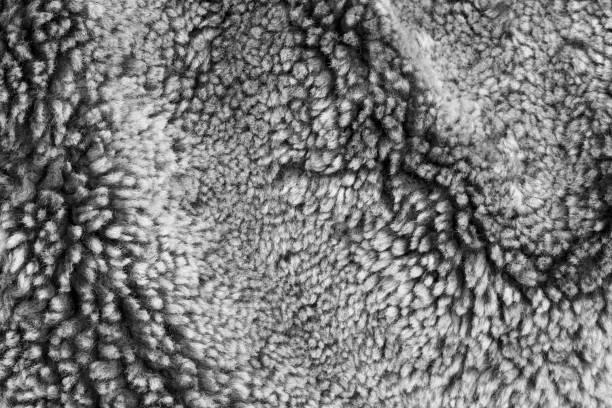
Velvet fabric is a luxurious textile characterized by a short, dense pile of evenly cut fibers, resulting in a soft, smooth nap and a distinctive sheen.
Historically woven from silk, modern velvet can be crafted from various fibers, including cotton, linen, wool, and synthetic materials like polyester and rayon, or blends thereof, making it more accessible for a wide range of applications. Its unique construction on a specialized loom creates a double layer of fabric that is then cut apart, forming the plush surface prized for its elegant appearance and rich texture, making it a popular choice for apparel, upholstery, and home décor.
Types of Velvet Fabric
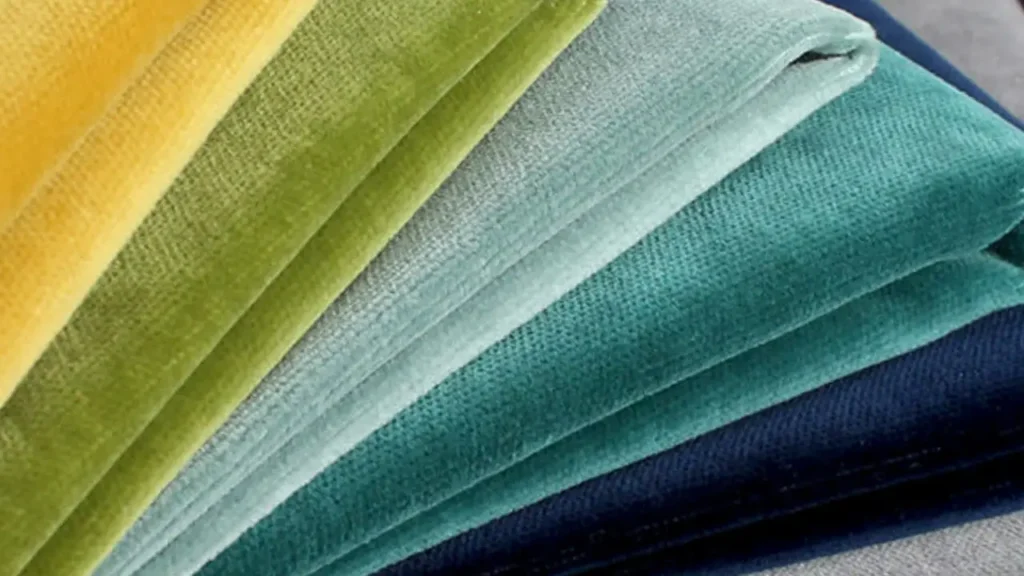
Velvet fabric, with its signature soft pile and luxurious sheen, comes in a fascinating array of types, each possessing unique characteristics that make it suitable for different applications.
Understanding these distinctions is key to selecting the perfect velvet for your project, whether it’s a glamorous gown or a cozy cushion. Let’s explore the diverse world of velvet fabrics.
Silk Velvet Fabric
Silk velvet stands as the epitome of luxury within the velvet family. Crafted from the delicate yet strong fibers of pure silk, this fabric boasts an unparalleled softness that glides to the touch and a captivating, luminous sheen that catches the light beautifully. Its exquisite drape and rich texture make it a favored choice for high-end couture, elegant eveningwear, and sophisticated home décor accents like decorative pillows and luxurious throws, adding an element of refined opulence to any setting.
However, the inherent delicacy and the intricate production process of silk contribute to its higher price point. Silk velvet often requires specialized care, typically dry cleaning, to maintain its pristine condition and prevent damage to its delicate fibers. While not as robust as some of its synthetic counterparts, the unmatched beauty and feel of silk velvet make it a worthwhile investment for those seeking ultimate luxury and timeless elegance in their creations.
Cotton Velvet Fabric
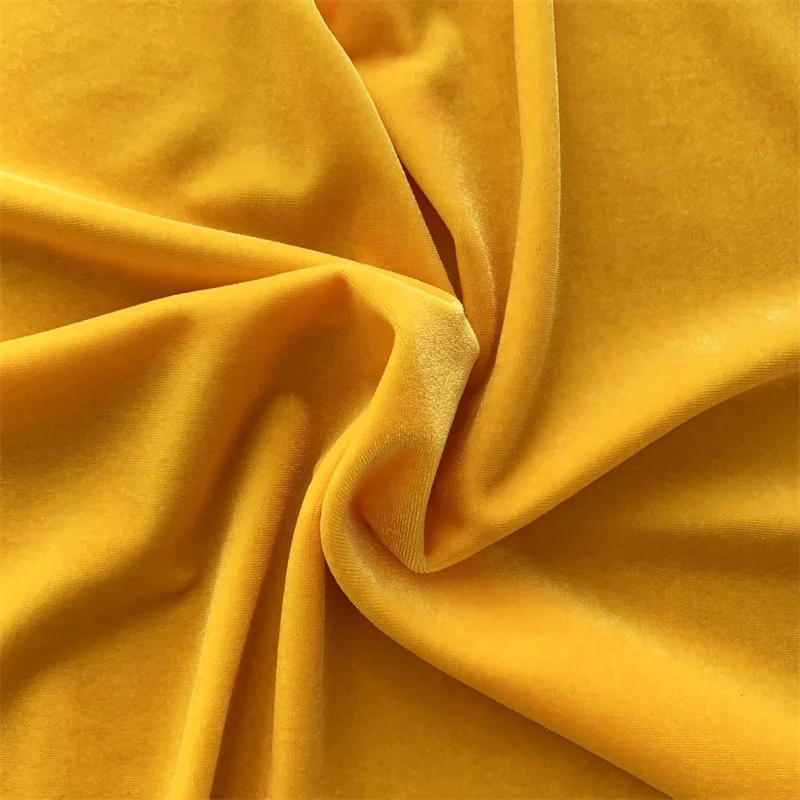
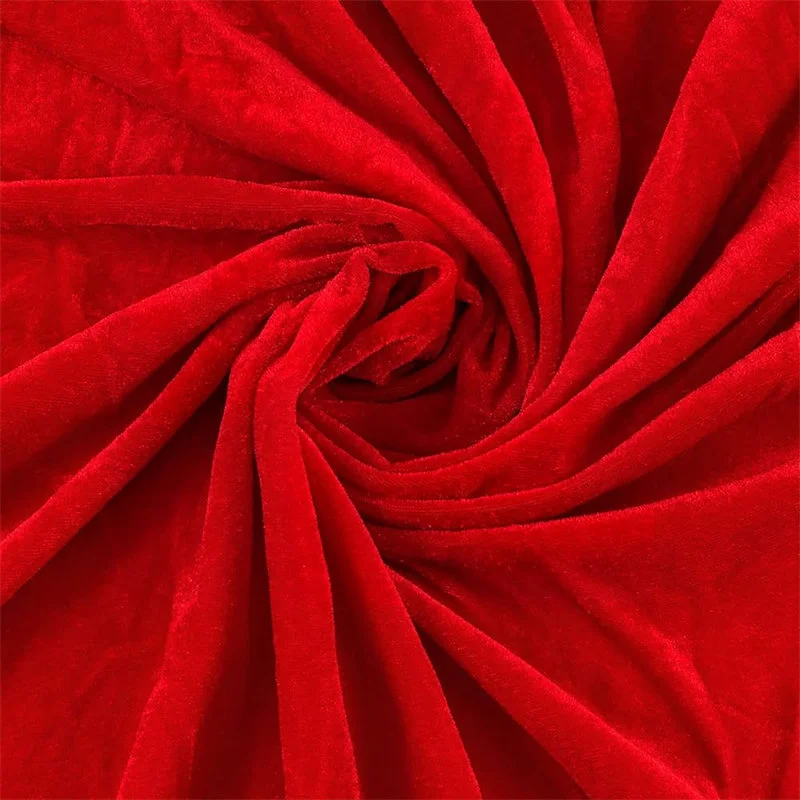
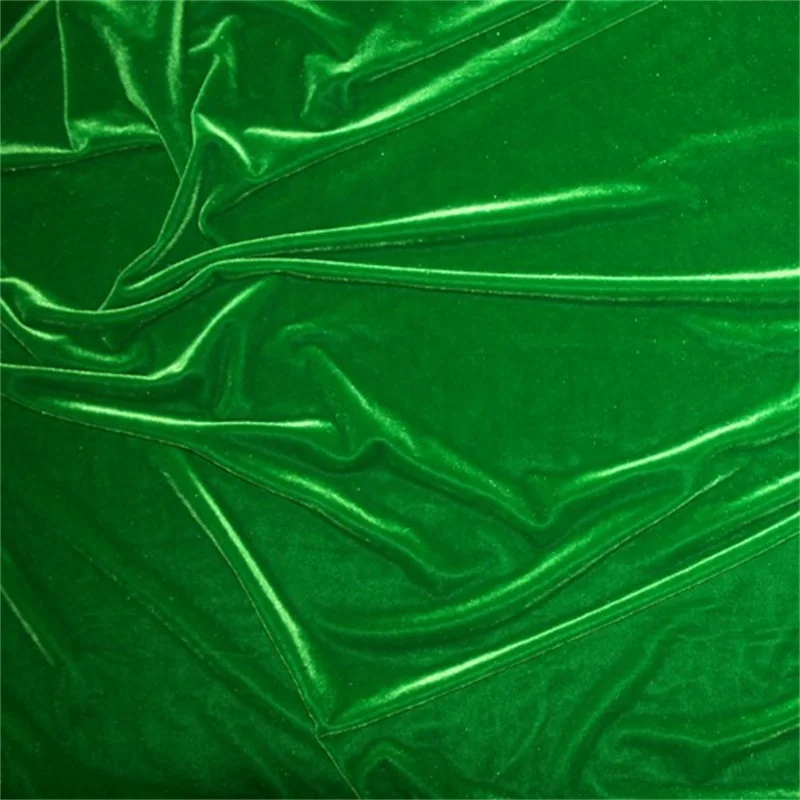
Cotton velvet, often referred to as velveteen, offers a more grounded and approachable alternative to its silken cousin. Woven from the versatile fibers of cotton, this type of velvet retains a soft, plush feel but presents with a more matte finish compared to the high gloss of silk. Its inherent durability and relative affordability make it a practical choice for a wide range of applications, from sturdy upholstery that can withstand daily use to comfortable and stylish curtains that add warmth to a room.
Furthermore, cotton velvet lends itself well to more casual clothing items, providing a touch of texture and depth to everyday wear. Its robust nature also means it is generally easier to care for than silk velvet, often being machine washable or dry cleanable depending on the specific weave and finish. This blend of comfort, durability, and affordability makes cotton velvet a popular and versatile option for numerous textile projects.
Rayon Velvet Fabric
Rayon velvet, also known as viscose velvet, seeks to capture the luxurious essence of silk velvet while offering a more accessible price point. Created from regenerated cellulose fibers, it exhibits a beautiful drape and a sheen that closely mimics the luster of natural silk, making it an attractive option for those desiring a touch of elegance without the premium cost. This type of velvet is frequently employed in the fashion industry for creating flowing dresses, stylish blouses, and eye-catching costume designs where visual appeal is paramount.
Additionally, rayon velvet finds its place in home décor, adding a soft and inviting texture to cushions, throws, and drapery. While it shares a similar aesthetic to silk, rayon velvet can be more susceptible to wrinkling and may require more careful handling during cleaning. Its delicate nature often necessitates dry cleaning to preserve its smooth finish and prevent damage to the cellulose fibers.
Nylon Velvet Fabric
Nylon velvet distinguishes itself through its remarkable durability and exceptional resistance to wear and tear. As a synthetic fiber, nylon inherently possesses strength and resilience, making nylon velvet a practical choice for applications that demand longevity and robustness. It is a common selection for upholstery in high-traffic areas and for automotive interiors where the fabric needs to withstand constant use and potential abrasion.
Often blended with other fibers, nylon enhances the overall strength and resilience of the resulting velvet, improving its ability to resist pilling and maintain its appearance over time. While it may not possess the same level of natural sheen or soft drape as silk or rayon, its utilitarian properties make it an invaluable option for demanding environments where practicality outweighs pure luxury.
Wool Velvet Fabric
Wool velvet offers a unique textural experience and the inherent warmth associated with wool fibers. Unlike the smooth surfaces of silk or rayon velvet, wool velvet presents a more textured feel and a subtle, natural matte finish. Its insulating properties make it a less common choice for typical velvet applications but highly valued for specific uses such as warm winter clothing, cozy accessories like scarves and hats, and even durable upholstery in colder climates.
The natural crimp of wool fibers contributes to the fabric’s resilience and ability to retain its shape. While it may not have the flowing drape of silk or rayon, wool velvet offers a substantial and comforting feel. Care requirements for wool velvet often involve gentle cleaning methods to avoid shrinkage or damage to the natural fibers, ensuring its longevity.
Polyester Velvet Fabric
Polyester velvet stands out as a highly versatile and budget-friendly synthetic option. Known for its excellent durability and resistance to common issues like wrinkling and fading, polyester velvet offers a practical alternative to natural fiber velvets. Its ease of care, often being machine washable, further enhances its appeal for everyday use in upholstery that needs to withstand spills and wear, fashionable yet low-maintenance clothing, and a wide array of home décor items.
While it may not possess the exact luxurious drape or the unique tactile qualities of natural fibers, advancements in manufacturing have allowed polyester velvet to achieve impressive levels of softness and a pleasing sheen. Its affordability and practicality make it a popular choice for mass-market applications where cost-effectiveness and easy maintenance are key considerations.
Crushed Velvet Fabric

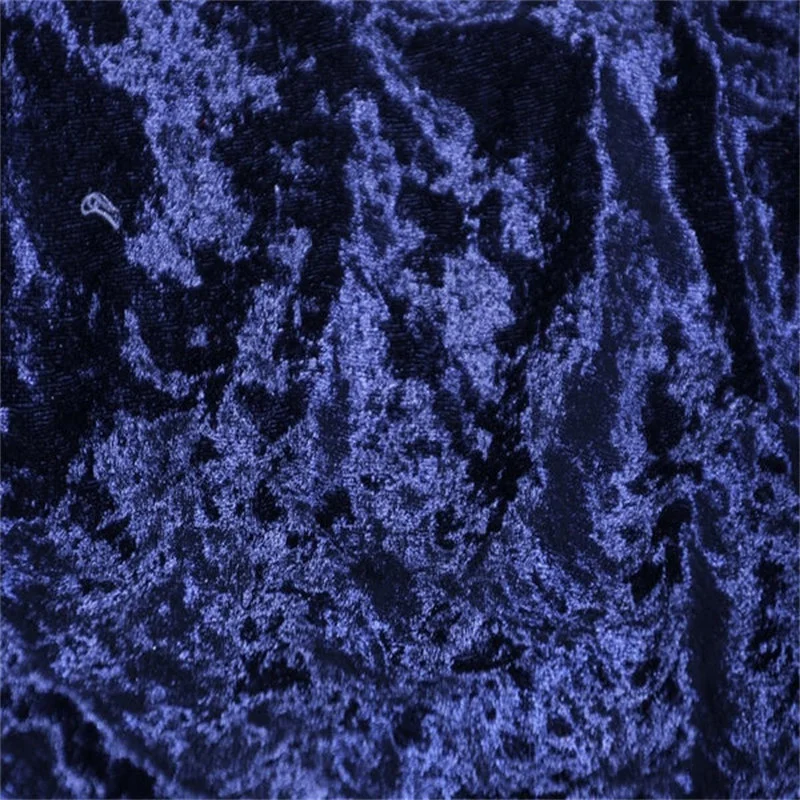
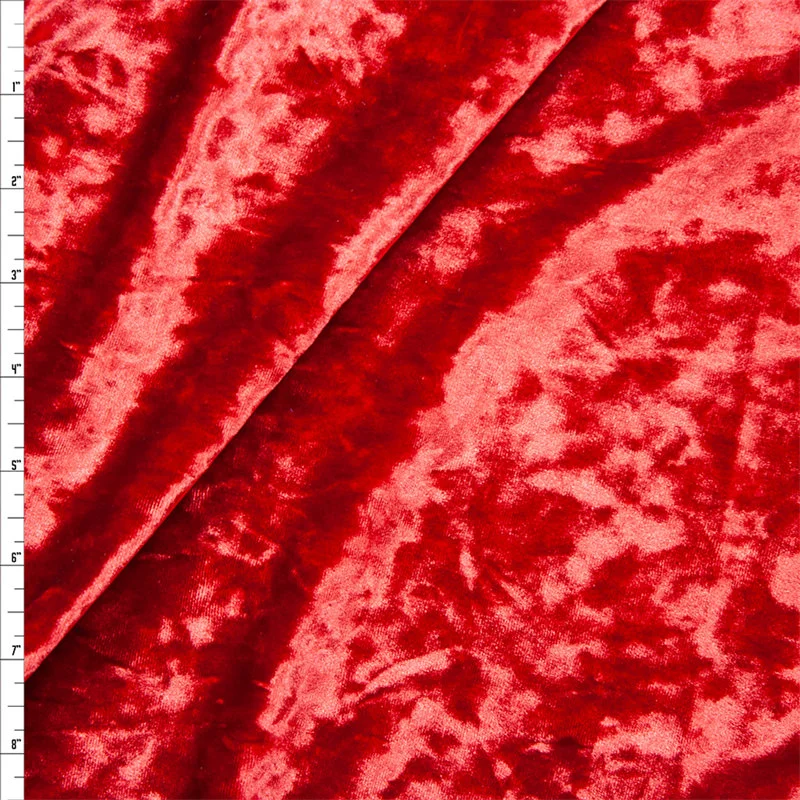
Crushed velvet is instantly recognizable by its distinctive, textured surface achieved through a deliberate process of twisting the fabric while it is wet. This technique creates a unique, irregular pattern that catches and reflects light in a dynamic and eye-catching manner, giving the fabric a shimmering, almost liquid appearance. Crushed velvet is a popular choice in the fashion world, particularly for creating dramatic evening wear, stylish tops, and statement accessories that demand attention.
The characteristic texture of crushed velvet also lends itself well to decorative home accents, adding a touch of vintage glamour to cushions and throws. While the crushing process alters the uniformity of the pile, it contributes to the fabric’s unique visual appeal and tactile interest. Care for crushed velvet often involves gentle handling to preserve its distinctive texture.
Stretch Velvet Fabric
Stretch velvet is a modern adaptation that combines the luxurious feel of velvet with the added benefit of elasticity. This is achieved by blending velvet fibers with elastic fibers such as spandex or Lycra. The resulting fabric offers both the rich texture and sheen of velvet along with a comfortable stretch that allows for ease of movement and a close, flattering fit. Stretch velvet is an ideal choice for creating fitted garments like dancewear, figure skating costumes, and stylish apparel that requires both elegance and flexibility.
The added stretch not only enhances comfort but also simplifies the construction of form-fitting designs. It allows garments to move with the body without restriction, making it a popular choice in performance wear. Care for stretch velvet typically involves gentle washing to maintain the integrity of both the velvet and the elastic fibers.
Embossed Velvet Fabric
Embossed velvet showcases intricate patterns and designs that are pressed into the fabric’s surface using heat and pressure. This decorative technique creates a three-dimensional effect, adding depth and visual interest to the plush texture of velvet. The embossed patterns can range from simple geometric shapes to elaborate floral motifs, making this type of velvet a versatile choice for adding a touch of sophistication to upholstery, luxurious drapery, and unique fashion accessories.
The raised patterns not only enhance the aesthetic appeal but also add a tactile dimension to the fabric. Embossed velvet can be created on various base velvets, such as cotton or synthetic blends, allowing for a range of textures and price points. Care requirements depend on the underlying velvet material and the intensity of the embossing.
Burnout Velvet Fabric
Burnout velvet, also known as devoré velvet, is a captivating textile created through a chemical process that selectively dissolves certain fibers in the fabric blend, leaving behind a semi-transparent pattern against the remaining velvet pile. This technique results in a fabric with contrasting textures and opacities, often featuring intricate and delicate designs. Burnout velvet is particularly popular in creating elegant evening wear, sheer blouses, and decorative scarves where the interplay of transparency and plushness adds a unique visual appeal.
The delicate nature of the burnout areas often requires gentle handling and careful cleaning, typically dry cleaning, to preserve the integrity of the fabric. The contrast between the rich velvet pile and the sheer areas creates a sophisticated and often ethereal aesthetic, making burnout velvet a favored choice for special occasion garments and artistic textile projects.
Velvet Pile Fabric
Velvet pile, while not a distinct type of fiber, refers to the characteristics of the cut fibers that create the fabric’s signature plush surface. The density and height of these fibers significantly impact the overall look and feel of the velvet. High-pile velvet features longer, thicker fibers that result in a deep, luxurious, and often more textured feel, with a rich, plush appearance. This type of pile can sometimes show more shading and movement.
Conversely, low-pile velvet has shorter, more densely packed fibers, creating a smoother, more uniform surface with a cleaner, often more lustrous finish. Low-pile velvets tend to be more durable and less prone to crushing. Understanding the difference in pile is crucial when selecting velvet, as it directly affects the fabric’s aesthetic, drape, and suitability for different end uses, from opulent upholstery to sleek apparel.
Types of Velvet Fabric for Sofa
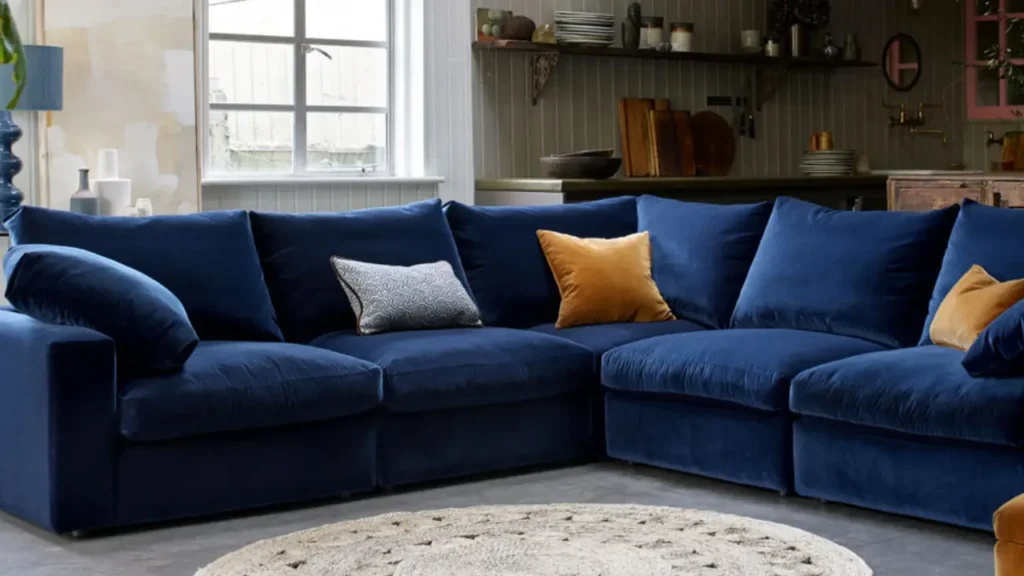
Selecting the right velvet for your sofa involves balancing aesthetics with durability and practicality. Sofas endure daily use, so the chosen velvet needs to withstand wear and tear while maintaining its luxurious appeal. Consider factors like stain resistance, ease of cleaning, and the overall texture and sheen that complements your décor. Certain types of velvet are better suited for this purpose due to their inherent properties.
Here are some popular and suitable types of velvet fabric for sofas:
Synthetic Blends: Velvets blended with fibers like rayon or nylon can offer a good compromise between softness, drape, and durability. These blends often aim to mimic the luxurious feel of natural velvets while improving their resistance to wear and staining, providing a versatile option for sofa upholstery.
Polyester Velvet: A synthetic option known for its excellent durability and resistance to stains, fading, and crushing. It’s a practical and often more affordable choice for households with children or pets, offering easy maintenance and a good balance of softness and resilience.
Mohair Velvet: Made from the hair of the Angora goat, mohair velvet is exceptionally durable and resistant to pilling and crushing. It boasts a distinctive luster and a slightly textured feel, making it a high-quality option for high-traffic areas. While more expensive, its longevity can make it a worthwhile investment.
Cotton Velvet (Velveteen): Offers a soft and natural feel with a less glossy finish compared to silk. While not as inherently durable as synthetic options like polyester, denser weaves of cotton velvet can still be suitable for sofas, especially in lower-traffic areas. Blends with other fibers can enhance its durability.
Types of Velvet Fabric for Dresses
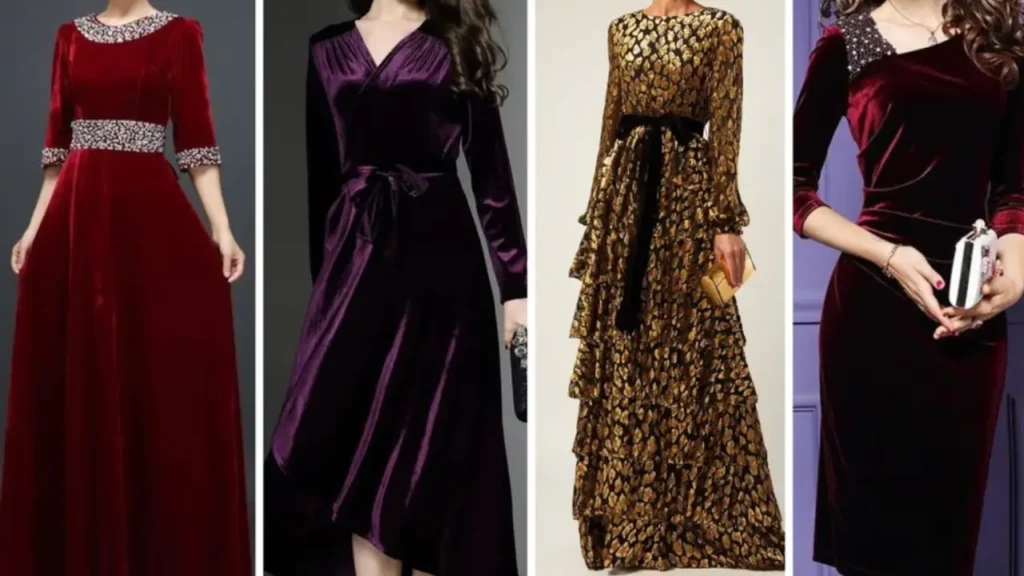
Choosing the right velvet for a dress depends largely on the desired style, drape, and occasion. Unlike sofas that prioritize durability, dress fabrics often emphasize fluidity, sheen, and the way they feel against the skin. Consider the garment’s design – will it be flowing and dramatic, or structured and fitted? The type of velvet will significantly influence the final look and comfort.
Here are some popular types of velvet fabric suitable for dresses:
Polyester Velvet: A more durable and often more affordable option, polyester velvet can be a good choice for dresses that require more resilience or easier care. While it may not have the same luxurious drape as silk or rayon, advancements in production have improved its softness and sheen, making it suitable for various dress styles.
Silk Velvet: The epitome of luxury, silk velvet offers a beautiful drape, a rich sheen, and an incredibly soft feel against the skin. It’s ideal for elegant evening gowns and special occasion wear where a fluid and sophisticated look is desired. However, it can be delicate and requires careful handling.
Rayon Velvet (Viscose Velvet): Provides a similar luxurious drape and sheen to silk velvet but at a more accessible price point. It’s a great choice for flowing dresses and skirts. However, it can be more prone to wrinkling and may not be as durable as some other options.
Stretch Velvet: Blended with spandex or Lycra, stretch velvet offers both the characteristic plushness of velvet and comfortable elasticity. It’s perfect for fitted dresses, dancewear, and costumes where ease of movement and a close silhouette are desired.
Crushed Velvet: With its unique textured surface and shimmering appearance, crushed velvet adds a vintage or glamorous touch to dresses. It’s often used for statement pieces and evening wear, creating a distinctive and eye-catching look.
Conclusion
Exploring the diverse world of velvet reveals a spectrum of textures, sheens, and drapes, each type offering unique characteristics for various applications. From the opulent shimmer of silk to the practical resilience of polyester and the distinctive patterns of crushed and embossed varieties, understanding these nuances empowers informed choices for both novice and experienced creators. The subtle differences in pile, fiber content, and construction significantly impact the final look and feel of any project.
Whether you’re envisioning luxurious apparel, durable upholstery, or elegant home décor, the right velvet fabric can elevate your creation. By considering the intended use, desired aesthetic, and specific properties of each type – such as stretch, texture, or care requirements – you can confidently select the ideal material to bring your vision to life with the perfect touch of plush sophistication.
Ready to embark on your next velvet project? Discover a wide selection of high-quality materials tailored to your needs. Get wholesale velvet fabric from us and experience the difference that premium textiles can make in your designs. Explore our extensive collection and let your creativity flourish with the rich beauty and versatility of velvet.
